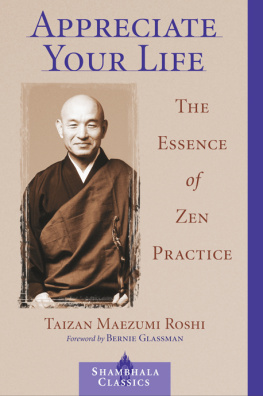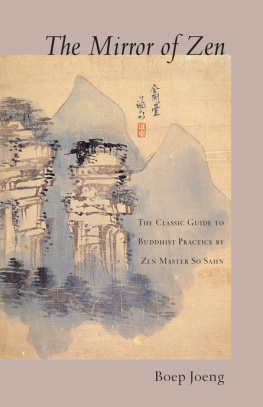An entertaining and even amusing survey of the varied flavors of Buddhism appears in The Compass of Zen, by Seung Sahn. Based upon his talks, this book presents the basic questions in many short, accessible chapters woven around anecdotes and dialogues. From the Four Noble Truths to the Five Human Dreams, this book seems to cover the whole mathematics of insight.
Michael Sims, Bookpage
Like two arrows meeting in the air, this extraordinary book meets the mind point. Please relax and enjoy it.
Joan Halifax, author of The Fruitful Darkness
ABOUT THE BOOK
The Compass of Zen is a simple, exhaustiveand often hilariouspresentation of the essence of Zen by a modern Zen Master of considerable renown. In his many years of teaching throughout the world, the Korean-born Zen Master Seung Sahn has become known for his ability to cut to the heart of Buddhist teaching in a way that is strikingly clear, yet free of esoteric and academic language. In this book,based largely on his talks, he presents the basic teachings of Buddhism and Zen in a way that is wonderfully accessible for beginnersyet so rich with stories, insights, and personal experiences that long-time meditation students will also find it a source of inspiration and a resource for study.
ZEN MASTER SEUNG SAHN (19272004) was the first teacher to bring Korean Zen Buddhism to America, having already established temples in Japan and Hong Kong. In 1972 he came to the United States and started what became the Providence Zen Center, the first center in what is now the Kwan Um School of Zen, which now includes more than eighty centers and groups worldwide. His students called him Dae Soen Sa Nim, Great Honored Zen Teacher, and he was the 78th Zen master in his line of dharma transmission in the Chogye order of Korean Buddhism. His books include The Compass of Zen, Dropping Ashes on the Buddha, Only Dont Know, and The Whole World Is a Single Flower: 365 Kong-ans for Everyday Life .
Sign up to learn more about our books and receive special offers from Shambhala Publications.

Or visit us online to sign up at shambhala.com/eshambhala.

The COMPASS of ZEN

Zen Master Seung Sahn
C OMPILED AND EDITED BY Hyon Gak Sunim
P REFACE BY Maha Ghosananda
F OREWORD BY Stephen Mitchell

SHAMBHALA
Boston & London
2012
S HAMBHALA P UBLICATIONS , I NC .
Horticultural Hall
300 Massachusetts Avenue
Boston, MA 02115
www.shambhala.com
1997 by the Kwan Um School of Zen
Cover art: The Sokkuram Buddha, Kyongju, South Korea.
All rights reserved. No part of this book may be reproduced in any form or by any means, electronic or mechanical, including photocopying, recording, or by any information storage and retrieval system, without permission in writing from the publisher.
Library of Congress Cataloging-in-Publication Data
Seung Sahn.
The compass of Zen/Zen Master Seung Sahn.1st ed.
p. cm.
eISBN 978-0-8348-2371-6
ISBN-13 978-1-57062-329-5 (pbk.: alk. paper)
ISBN-10 1-57062-329-5
1. Zen Buddhism. I. Title.
BQ9266.S47 1997 97-14070
294.3927dc21 CIP
CONTENTS
S HAKYAMUNI B UDDHA always gave very important teachings about karma, or the law of cause and effect. He laid down this law very simply in the Four Assurances: This holy life of practice of Dharma, if livedand should there be a heaven after allis paradise, and will assure the students long enjoyment of it. If there is no world beyond, at least in this very life the one who follows Dharma will be truly free from hostility and affliction. If the law of karma is indeed effective and true, then people who do no ill cannot suffer. Even if the law of karma is not effective, however, still their life of purity will always gain for them the praise of their intelligent fellow men and women, and bring happiness in this life. These are the Four Assurances of the Buddha. If anyone accepts the teachings of the Dharma they will obtain the fruit of these Four Assurances. These Four Assurances are for all students of the Buddha.
I first came to America on October 10, 1980. My country was having a terrible conflict. I came to do peace work here and to assist at the World Conference on Religion and Peace, being held under the auspices of the United Nations and U. N. Church for Peace. Cambodia was having many problems from war and civil strife, and many people were dying. But nobody seemed to notice. When I arrived I had no place to stay, and almost no resources. Very soon after coming here, I met Zen Master Seung Sahn. Later I learned that he was the seventy-eighth patriarch in the Zen lineage from Bodhidharma and the Buddha, a great master from Korea, but at that time I saw only a humble monk. He gave me a place to stay and helped me do my work when none would let me in or support me. Almost no one was interested.
I was worrying very much how I could bring attention to the situation in my country. But even though we did not know each other at that time, Zen Master Seung Sahn immediately took me in. Still, I worried a lot. He said, You are a monk, so you shouldnt worry.
Why? I asked.
He told me, You are a monk, so you already have four million dollars! I could not believe what he was saying. It sounded a little crazy to a Theravada monk. What do you mean?
Since you are a monk, any temple in the world is your home, so you already have one million dollars. Also, you will always receive clothes from your students, so thats two million dollars. For your whole life, many people will always give you food so that you can practice and teach other people the Dharmathats three million dollars. Next, everybody will give you medicine when your body is sick: thats four million dollars. All you have to do is practice and teach other people the Dharma. It is very simple. You are a monk, so you are also a millionaire. Why should you worry? Ha ha ha ha!
Zen Master Seung Sahn is my great teacher and very best friend. When I was in New York he gave me shelter, food, medicine, and clothes. He showed me real lovingkindness. He even asked me to give teachings from my tradition to his own students in his Zen center, where I lived. He let me stay as long as I liked, to spread the Dharma in the United States and to help my own country. I will never forget this.
Dont know. Go straight. This is Zen Master Seung Sahns life and his teaching. If we do this, then we have no problems; when we have no problems, there is no tension. We always have tension because of problems: problems of the past, and problems of the future. But when there is no problem, there is no tension.
Everything about Zen Master Seung Sahn is Zen teaching. He is always here and now, in the present moment, in all his actions. This is very, very rare. When he is sitting, standing, walking, eating, talking, listening, and workingevery moment, his life is always very clear. That is why he is such a great master. His teaching is clearly visible in every moment, in all his actionsverbal, physical, and mental. He has always been this way, ever since I met him.
Zen teaching embraces all teachings, including the Theravada. The Eightfold Path of Right Understanding, Right Thought, Right Speech, Right Action, Right Livelihood, Right Practice, Right Mindfulness, and Right Meditation are all found in Zen, as you will see in this book. So are the Four Noble Truths. Therefore we all follow the great Zen Master Seung Sahn as our master, teacher, and friend.
Next page















